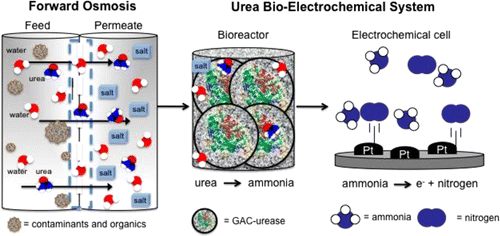On the less glamorous side of space exploration, there's the more practical problem of waste—in particular, what to do with astronaut pee. But rather than ejecting it into space, scientists are developing a new technique that can turn this waste burden into a boon by converting it into fuel and much-needed drinking water. Their report, which could also inspire new ways to treat municipal wastewater, appears in the journal ACS Sustainable Chemistry & Engineering.
Eduardo Nicolau, Carlos R. Cabrera and colleagues point out that human waste on long-term journeys into space makes up about half of the mission's total waste. Recycling it is critical to keeping a clean environment for astronauts. And when onboard water supplies run low, treated urine can become a source of essential drinking water, which would otherwise have to be delivered from Earth at a tremendous cost.
Previous research has shown that a wastewater treatment process called forward osmosis in combination with a fuel cell can generate power. Nicolau's team decided to build on these initial findings to meet the challenges of dealing with urine in space.
They collected urine and shower wastewater and processed it using forward osmosis, a way to filter contaminants from urea, a major component of urine, and water. Their new Urea Bioreactor Electrochemical system (UBE) efficiently converted the urea into ammonia in its bioreactor, and then turned the ammonia into energy with its fuel cell.
The system was designed with space missions in mind, but "the results showed that the UBE system could be used in any wastewater treatment systems containing urea and/or ammonia," the researchers conclude.
More information: "Evaluation of a Urea Bioelectrochemical System for Wastewater Treatment Processes" ACS Sustainable Chem. Eng., 2014, 2 (4), pp 749–754. DOI: 10.1021/sc400342x
Abstract
Due to the high cost of delivering supplies to space, the recovery of potable water from spacecraft wastewater is critical for life support of crewmembers in short- and long-term missions. It is estimated that in future long-term space missions, human wastes such as urine will contribute more than 50% of the total waste. Thus, we will demonstrate how unused components, such as urea, can be recovered and reused in wastewater recycling processes. In this system, a urea bioreactor (GAC-urease) converts urea to ammonia. Then, an electrochemical cell converts the ammonia to power. The combined system is referred to as the Urea Bioreactor Electrochemical (UBE) unit. The results of this research showed the feasibility of interfacing wastewater-recycling processes with bioelectrochemical systems to achieve water recycling while reusing useful resources. The UBE systems removed >80% of organic carbons and converted approximately 86% of the urea to ammonia. Therefore, the concept herein proposed has the potential to be used in water recycling applications with emphasis in contaminant recovery from wastewater for useful resources and energy.
Provided by American Chemical Society






















